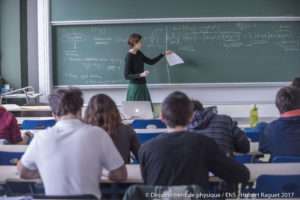Dario Villamaina came to the Institute in the autumn of 2013. He had obtained his PhD in Rome in 2011 and had done a first postdoc at the LPTMS in Paris-Orsay.
His research activity is both in non-equilibrium statistical mechanics and on random matrices [22, 23, 24, 25].
D. Villamaina studied the behaviour of a moving wall in contact with an interacting particle gas and subjected to an external force [24]. He derived the fluctuations of the system both in the microcanonical and canonical ensembles, showing how static and dynamic correlations signal significant differences with respect to the standard thermodynamical limit. In the same spirit, in collaboration with E. Trizac, D. Villamaina analyzed the fluctuations of the number of particles in a finite-size interacting fluid and their finite size effects which should be taken into account to obtain a meaningful thermodynamic compressibility [23]. He also investigated the finite-size structure factor that can be viewed as a scale dependent compressibility living in Fourier space.
In collaboration with A. Sarracino, he wrote a review article [25] about some recent results on the behaviour of fluctuations in the framework of molecular motors, pointing out some analogies shown by the large deviations of quantities such as work and entropy production in different systems. These common features reveal some underlying symmetry properties governing the non-equilibrium behaviour of Brownian motors.
Regarding the other research interest in random matrix theory, D. Villamaina showed how the fluctuations of the spin glass susceptibility in the Sherrington-Kirk-patrick model can be mapped onto an invariant random matrix ensemble where the standard Gaussian potential is distorted by an additional single pole. He then computed the average spectral density in the limit of large matrix size, solving the loop equation [22].
In a recent project, in collaboration with M. Barbier and E. Trizac (LPTMS, Paris-Sud), he studied the dynamics of a localized intense explosion in a dissipative gas [26]. This is a quite hard problem in hydrodynamics because of the presence of strong non-linear effects. Moreover, because of the presence of dissipation, the standard approach does not work. They provided a detailed analysis of the structure of the blast by combining molecular dynamics simulations and scaling analysis of hydrodynamic equations. This twofold approach has permitted on one hand to rationalize the qualitative arguments already present in literature and, on the other hand, to unveil a new corrugation instability in the structure of the crust.
D. Villamaina also got interested to a new direction of research, concerning the applications of random matrix theory to correlation data analysis. Determining correlations among variables starting from some observations is a common problem in statistics. In these cases, one deals with some estimators of correlation matrices, which are affected by finite sampling.
In collaboration with Rémi Monasson (LPTENS), they have described a general formalism for the calculation of the average scalar products between the empirical eigenvectors (namely the eigenvectors of the correlation matrix estimator) and the real ones of a correlation matrix [27].
This theoretical work opens the door to several possible applications, and D. Villamaina is now starting a new project, applying this techniques on protein sequence analysis, in collaboration with Simona Cocco (LPS-ENS) and Martin Weigt (Paris-6).
After 2 years at the Philippe Meyer Institute, Dario Villamaina stayed a third year at the ENS on a different grant, and then moved to a permanent scientist position at Capital Fund Management, Paris.

MENUMENU
- Laboratoire
-
-
LABORATOIRE

-
-
-
- Recherche
-
-
ASTROPHYSIQUE, COSMOLOGIE ET GRAVITATION
- Présentation
- Liste Equipes Axe Astrophysique, Cosmolgie et Gravitation
-
INTERACTIONS FONDAMENTALES
- Présentation
- Liste Equipe Axe Interactions Fondamentales
-
PHYSIQUE STATISTIQUE
- Présentation
- Liste Equipe Axe Physique Statistique
-
-
- Formation
- Diffusion des connaissances
-
-
DIFFUSION DES CONNAISSANCES

-
-
- Institut Philippe Meyer (IPM)
- Intranet
Sélectionner une page







